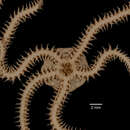fr
noms dans le fil d’Ariane


“Amphioplus acutus, n.sp.
(Plate VIII, fig. 14)
St. 180. 11. iii. 27. Schollaert Channel, Palmer Archipelago, 160 m. 5 specimens.
St. 181. 12. iii. 27. Schollaert Channel, Palmer Archipelago, 160-335 m. Several specimens.
St. 182. 14. iii. 27. Schollaert Channel, Palmer Archipelago, 278-500 m. 4 specimens.
St. 190. 24. iii. 27. Bismarck Strait, Palmer Archipelago, 315 m. 1 specimen.
Diameter of disk up to 9 mm.; arms slender, about seven to eight times the diameter
of disk. The outline of the disk is usually pentagonal, the interradial edges straight or
at most gently concave.
The disk is covered by rather large, imbricating scales, among which the primary
plates are not very distinctly seen. In the interradii the scaling of the underside
generally continues some distance on the dorsal side, forming a rather well limited area
because the scales here imbricate in the opposite direction to that of the scales of the
dorsal side of the disk. The radial shields are narrow, straight, diverging, widely
separated in their whole length; they are a little more than one-third the disk radius.
The ventral interradii are covered throughout by small, more or less rounded scales,
much finer than those of the dorsal side of the disk.
Buccal shields almost quadrangular, with inner and lateral angles almost right, but
the distal angle rounded ; the sides, particularly the inner ones, straight. The madreporite
is usually conspicuous, with an irregular circle of very distinct pores, each on a
slight elevation, the more distinct as its colour is lighter than the general colour of the
plate. Adoral plates not prolonged outwards so as to separate the first lateral plate from
the buccal shield. The jaws are rather elongate. The mouth papillae are four (five) on
each side; the outermost one is small, scale-like, the two following ones long and
pointed, spine-like ; the infradental papillae are small, sometimes somewhat irregular ;
also the papilla of the first mouth tentacle may be double.
The first ventral plate is small, with somewhat rounded distal edge; the following
ventral plates slightly contiguous, somewhat broader than long, with lightly convex
outer edge; the outer corners rather sharp. Dorsal arm plates broader than long,
biconvex. Arm spines four, slender, conical, pointed, smooth. Tentacle scales typically
two, but the one along the ventral plate often much smaller than the outer scale or
totally lacking. Colour in alcohol dark grey.
One specimen, St. 181, has only four rays.
The species has separate sexes and is not viviparous.
In the elongate, pointed mouth papillae this species differs conspicuously from
the other Antarctic species of Amphioplus (or Amphiodia). The same character is found
in Amphioplus gastracanthus (Lütken and Mortensen) and A. notacanthiis (Lütken and
Mortensen) (Ophiuroidea of the Albatross Expedition, 1891, pl. xiii, figs. 4, 7); but these
species are in other respects so different from the present species that there is hardly any
close affinity between them. In A. dispor (Koehler) ('Investigator' Ophiuroidea, 1,
pl. x, fig. 81) one of the distal mouth papillae is long and spiniform; but this species
otherwise has no resemblance to the present species.
To this species I must refer also some young specimens, up to 2-5 mm. diameter of
disk, from St. 182. They differ conspicuously from the typical adult Amphioplus acutus
in having only a single (but slender, spiniform) outer mouth papilla, and in having only
three arm spines (exceptionally a joint here and there may have four spines). Otherwise
they agree completely with A. acutus, and as I find specimens of 3 mm. diameter of disk
with the mouth papillae typically developed as in the adults, but still with only three
arm spines, I cannot have any doubt but that these young specimens are actually the
young Amphioplus acutus; the spiniform outer mouth papilla is thus the first to develop,
and the species is passing through an Amphuira stage. It may be added that I have
ascertained that gonads have not yet appeared in these young specimens.”
(Mortensen, 1936; 294-296)
Amphioplus acutus is een slangster uit de familie Amphiuridae.
De wetenschappelijke naam van de soort werd in 1936 gepubliceerd door Theodor Mortensen.
Bronnen, noten en/of referenties